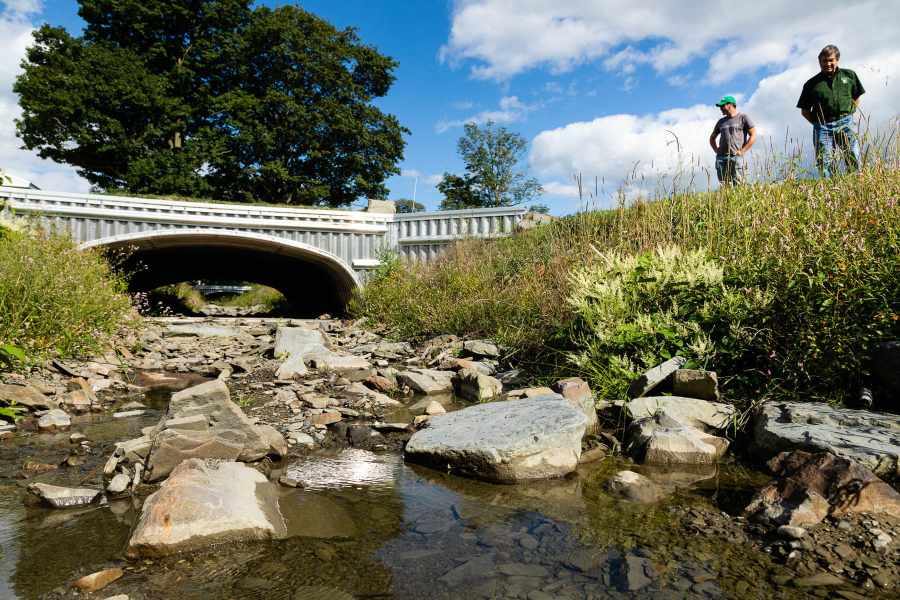Fish Blockages
Dams, culverts and other barriers cause harm to migratory fishes while impacting water quality.

Overview
Fish blockages such as dams and reservoirs have served an important purpose of harnessing water energy and providing drinking water, while infrastructure such as culverts allow water to pass under roads and neighborhoods. However, these constructions keep fish from migrating and can cause negative impacts to stream health.
How do fish blockages impact the Bay?
Impacts on marine life
Migratory fish such as shad and herring live most of their lives out in the ocean, but then migrate to the freshwater rivers and streams of the Chesapeake Bay to spawn. When barriers exist, these fish have difficulty reaching spawning grounds, and their fry will have trouble migrating back down the river. Other fish such as brook trout spend all their life in the freshwater streams and rivers, but still count on being able to move up and down the waterways to spawn, access food and escape predation. This issue has major implications for those who harvest fish from the river. In Pennsylvania, for instance, large hydroelectric dams effectively closed the shad fishery on the Susquehanna River.
Impacts on stream health
Dams and reservoirs can also worsen the water quality of streams and rivers. In some cases, these barriers slow the flow of water which increases the temperature, making waterways inhabitable for freshwater species such as brook trout. Disrupting the stream flow can also decrease the amount of dissolved oxygen in the water, which makes conditions unsuitable for fish and plant life. Barriers such as culverts can also produce sediment pollution if not properly constructed. When the culverts are too small or too high up, the flow from the water is so strong that when it empties into the stream, it causes sediment at the bottom of the bed to detach and float to the top of the water. These indentations at the bottom of a stream bed are known as scour pools.
What’s being done to increase fish passage?
Barrier removal
Across the watershed, barriers large and small are being removed to allow for better fish passage. In 2016, the Chesapeake Bay Program’s Fish Passage Workgroup reached their 2025 goal to open an additional 1,000 stream miles, established in the 2014 Chesapeake Bay Watershed Agreement. In January 2020, we set a new target to open an additional 132 stream miles every two years to fish passage.
Featured Highlights by State
- Virginia: Since the removal of the Embrey Dam in Virginia, migratory species including alewife, blueback herring, hickory shad and American shad have been documented in the Rappahannock five miles upstream. In addition, American shad, blueback herring and striped bass have been documented as far as 28 miles upstream of the removal site.
- Maryland: Maryland celebrated the removal of Bloede Dam on the Patapsco River in 2018. Since then, migratory fish such as striped bass, river herring and white perch have been recorded upstream of the removal site. Environmental DNA (also known as eDNA) from several other migratory species has been collected at the base of Daniels Dam, which is over 6 miles upstream of the removal site.
- Pennsylvania: Prior to two dam removals in 2015 and 2018, Chiques Creek in Pennsylvania, was not accessible to fish migrating from the Susquehanna River. Following the removals of Heistand Sawmill Dam and Krady Mill Dam, the watershed now serves as a unique case study in free-flowing conditions and sediment management best practices. Additional work is being done to further increase aquatic connectivity.
Barrier upgrades
Dams and culverts have also been upgraded to mitigate their impacts on fish passage and stream health. In 2021, the Chesapeake Bay Program funded research to identify culverts in West Virginia’s Opequon Creek watershed that were both limiting fish passage and causing sediment runoff. Whenever a road or building is built over a waterway, a culvert is made to allow the water (and marine life) to pass through and continue on the other side. However, many of these culverts are outdated and were poorly designed. Culvers can be too narrow, too high off the ground, or feature double-barrels, all of which cause excess sediment in streams.
Fish ladders
Resource managers have also installed lifts and ladders that help fish make it across dams. Fish steps are a series of small pools of water that fish have an easier time moving up. Some steps include areas of still water for fish to rest. Fish lifts are mechanisms that fish can swim into and elevate them up over the dam. At the Conowingo Dam in the Susquehanna River, for instance, a fish lift operated by fishery biologists helps thousands of fish a week make it over the dam.
What you can do
To restore fish passage, landowners can remove dams from rivers and streams on their properties or install appropriate fishways if dam removal is not a feasible option. Landowners can also ensure that culverts and bridges are large enough to maintain streams and rivers in their natural condition without impeding flow and causing blockages for fish. To protect brook trout, shad and other migratory fish, anglers can also follow fishing regulations and practice proper catch-and-release techniques. For more information about dam removal and culvert replacement in your state, contact Virginia Department of Wildlife Resources, Maryland Department of Natural Resources or Pennsylvania Fish and Boat Commission.
